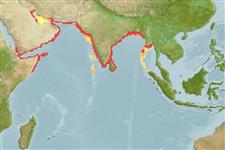分類 / Names
俗名 | 同種異名 | Catalog of Fishes(屬, 種) | ITIS | CoL | WoRMS | Cloffa
Teleostei >
Clupeiformes (Herrings) >
Dorosomatidae (Gizzard shads and sardinellas)
Etymology: Tenualosa: Latin, tenuis = thin + Latin, alausa = a fish cited by Ausonius and Latin, halec = pickle, dealing with the Greek word hals = salt; it is also the old Saxon name for shad = "alli" ; 1591 (Ref. 45335).
More on author: Hamilton.
Environment: milieu / climate zone / depth range / distribution range
生態學
海洋; 淡水; 半鹹淡水; 溯河洄游 (Ref. 127664); 深度上下限 ? - 200 m. 熱帶; 34°N - 5°N, 42°E - 97°E (Ref. 188)
Indian Ocean: Persian Gulf eastward to Myanmar, including western and eastern coasts of India. Reported from the Gulf of Tonkin, Viet Nam (Ref. 9706). Reported in Tigris River basin and probably other rivers of southern Iran (Ref. 39702).
印度洋: 波斯灣向東至緬甸,包括印度的西岸與東岸。 記錄來自越南的東京灣了。 (參考文獻 9706) 在底格里斯河流域與伊朗南部的可能其他河中報告。 (參考文獻 39702)
Length at first maturity / 大小 / 重量 / 年齡
Maturity: Lm 31.3, range 18 - ? cm
Max length : 60.0 cm SL 雄魚/尚未辨別雌雄; (Ref. 188); common length : 36.0 cm SL 雄魚/尚未辨別雌雄; (Ref. 4832); common length :42 cm TL (female); 最大體重: 680.00 g (Ref. 4832); 最大體重: 680.00 g; 最大年齡: 5 年 (Ref. 43871)
背棘 (總數) : 0; 背的軟條 (總數) : 18 - 21; 臀棘: 0; 臀鰭軟條: 18 - 23. Belly with 30 to 33 scutes. Distinct median notch in upper jaw. Gill rakers fine and numerous, about 100 to 250 on lower part of arch. Fins hyaline. A dark blotch behind gill opening, followed by a series of small spots along flank in juveniles. Color in life, silver shot with gold and purple.
腹面有 30 到 33個鱗甲。 在上頜中明顯的中央凹槽。 鰓耙細且多, 大約 100 到 250 在弓的較下面的部位上。 鰭透明的。 被跟隨著一系列的小斑點的一個黑色斑塊在後鰓裂在稚魚中沿著側面。 顏色活著時, 用黃金與紫色的銀色注射。
Schooling in coastal waters and ascending rivers for as much as 1200 km (usually 50-100 km). Migration though is sometimes restricted by barrages. Hilsa far up the Ganges and other large rivers seem to be permanent river populations. Feeds on plankton, mainly by filtering, but apparently also by grubbing on muddy bottoms. Breeds mainly in rivers during the southwest monsoon (also from January to February to March). Artificial propagation has been partially successful in India (Ref. 4832). Known to be a fast swimmer, covering 71 km in one day (Ref. 12203). Marketed fresh or dried-salted.
群游於沿岸水域而且溯河高達 1200 公里.(通常 50- 100 公里) 遷移雖然有時被障礙限制。 Hilsa 向上遠達恒河,而且其他的大河似乎是永久的河川族群。 吃浮游生物,主要地藉著過濾, 但是顯然地也藉著翻掘在泥底部上。 在西南季風的時候主要在河中繁殖。 (也從一月到二月到三月) 人工繁殖在印度已經部份成功。 (參考文獻 4832) 已知是一位快速的游泳者, 包含的 71 公里在一天內.(參考文獻 12203) 在市場上銷售生鮮地了或乾燥鹽醃。
Breeds mainly in rivers, upstream to about 50 km or even over 1000 km as in the Ganges (younger fishes may breed in the tidal zone of rivers). In some rivers the migration is restricted by barrages; there is some evidence that hilsa far up the Ganges and other large rivers, although migrating upstream to spawn, are permanent river populations that do not descend to the sea. The main breeding season is during the southwest monsoon, with a shorter season from January to February or March.印度洋: 波斯灣向東至緬甸,包括印度的西岸與東岸。 記錄來自越南的東京灣了。 (參考文獻 9706) 在底格里斯河流域與伊朗南部的可能其他河中報告。 (參考文獻 39702)
Whitehead, P.J.P., 1985. FAO Species Catalogue. Vol. 7. Clupeoid fishes of the world (suborder Clupeoidei). An annotated and illustrated catalogue of the herrings, sardines, pilchards, sprats, shads, anchovies and wolf-herrings. FAO Fish. Synop. 125(7/1):1-303. Rome: FAO. (Ref. 188)
人類使用
漁業: 低經濟; 養殖: 實驗的
工具
特別的報告
下載 XML
網路資源
Estimates based on models
Preferred temperature (Ref.
123201): 21.3 - 28, mean 24.7 °C (based on 224 cells).
Phylogenetic diversity index (Ref.
82804): PD
50 = 0.5312 [Uniqueness, from 0.5 = low to 2.0 = high].
Bayesian length-weight: a=0.00912 (0.00801 - 0.01039), b=3.03 (2.99 - 3.07), in cm total length, based on LWR estimates for this species (Ref.
93245).
營養階層 (Ref.
69278): 2.9 ±0.29 se; based on food items.
回復力 (Ref.
120179): 中等的, 族群倍增時間最少 1.4 - 4.4年 (K=0.3-1.2; tmax=5; tm=2; Fec=220,000).
Prior r = 0.59, 95% CL = 0.39 - 0.89, Based on 4 data-limited stock assessments.
Fishing Vulnerability (Ref.
59153): Low to moderate vulnerability (29 of 100).
Climate Vulnerability (Ref.
125649): Very high vulnerability (84 of 100).
Nutrients (Ref.
124155): Calcium = 67.3 [52.4, 88.0] mg/100g; Iron = 2.07 [1.20, 3.36] mg/100g; Protein = 17 [16, 18] %; Omega3 = 0.619 [0.299, 1.262] g/100g; Selenium = 55 [24, 131] μg/100g; VitaminA = 16.3 [5.8, 45.1] μg/100g; Zinc = 1.09 [0.70, 1.79] mg/100g (wet weight); based on
nutrient studies.
